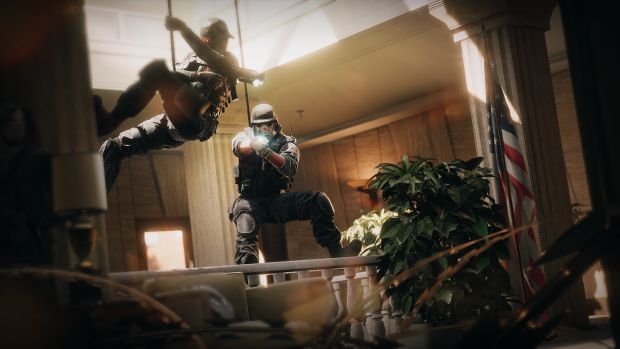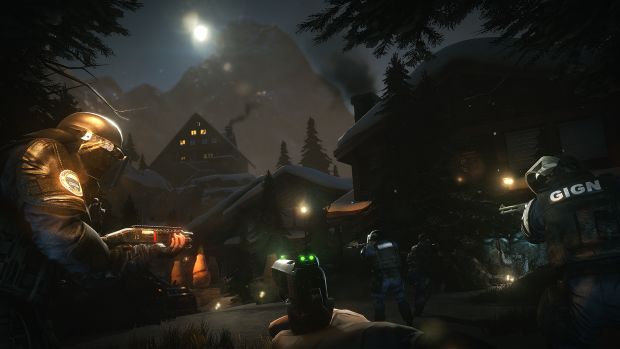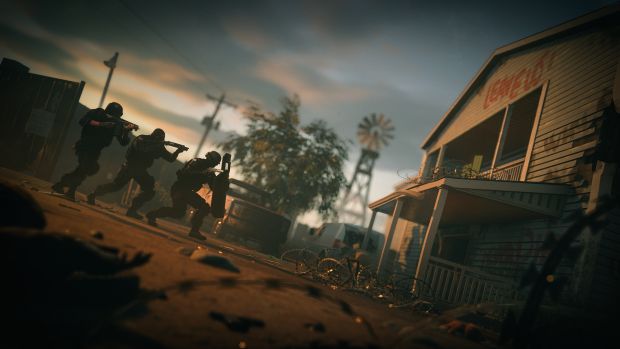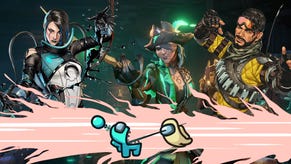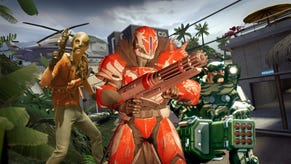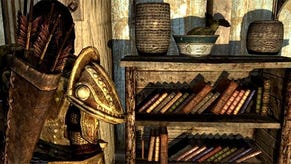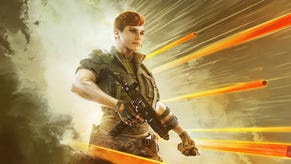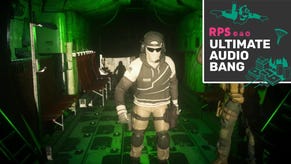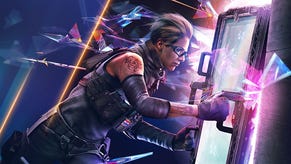Hands On - Rainbow Six: Siege
The thinking grunt's shooter.
Rainbow Six Siege [official site] is being held hostage in its last stages of development. We dispatched Brendan to breach and clear and also write about it.
The latest Rainbow Six game begins with Angela Bassett telling you that a new terrorist threat has made itself known. One with incomparable resources and intelligence. She's getting the band back together, and giving you all the power you need to hunt these villains down. "Borders and protocols," she says, "are irrelevant". Apart from being a shocking dismissal of international law, this sentence sums up the game pretty well. See that wall? Irrelevant. See that door? Immaterial. And why should we use the front door, like good neighbours, when we can just blow a hole in the goddamn ceiling?
Ubisoft's new tactical shooter has already been through its beta, as Pip and Graham have experienced. But I was given the chance to play through a more complete version. The first mode I played was 'Situations', a singleplayer dry run of the whole concept. I crouch-walked my way around an airplane in the first mission, inexpertly shooting baddies in the feet until there were no more baddies left. In another mission, I defended a vulnerable hostage from waves of explosive-smitten terrorists by setting traps and blockading doorways. And in the final operation I rescued and escorted another hostage from a fortified winter chalet by patiently zipping around with a robot drone, marking the positions of my foes, then barging in. At the end of each mission I was awarded a rating for any special objectives.
It was an interesting little romp but I could tell this was less a highlight and more of a necessary introduction to the tone and pace of the game. A kind of tutorial.
"In a sense it is a way to get the players into the game, to kind of learn it," says Chris Hendry, Senior Environment Artist. "And then they can move onto multiplayer."
But he also says that on harder difficulties, the mode stretches itself out.
"When you start to play with the other difficulties... there'll be more enemies, they'll be more reactive. It becomes very very challenging."
Sure enough, I played through Situations mode's plane level again on 'Realistic' and noticed that the enemies were firing on me much quicker as well as being far more alert to my approaches. I was still able to get by without too much trouble, so long as I was careful. But it was more of a battle. The bad guys were blasting holes straight through walls once they knew I was there.
These destructible walls are the meaty chunks in Siege's soup. In the game's co-op Terrohunt mode, your team is tasked with eliminating all enemies in a map. A return to the good old days of Clancy games. There are a lot of places to blast your way into each hideout and some of the maps we played were disarmingly big. You quickly learn that splitting up over too far is lunacy. In 'Kanal', we flashbanged and murdered our way through a warehouse only to realise there was another adjacent warehouse on the opposite side of the level where the last 10 lousy terrorists had holed up. In Club House, we tried to surround and infiltrate the headquarters of a motorcycle gang, only to be routinely shot dead in the cavernous basement.
The appeal of this mode obviously lies in going in with a crack team of friends, or even a single partner, and hitting each enemy perfectly before swiftly moving on to the next, wiping out every room in a 'perfect run' - check those corners, the action movie ideal. That harks back to the perfectionism of the original game, and it speaks to the methodical among us. As does the ability to put down a tiny robot drone before you enter the building and speed through the map, tagging all the enemies. You can do this at any time, but it does leave the "real you" vulnerable.
For some reason, I loved this robot. It appealed to my sense of caution. My teammates always got bored of this scouting stage very quickly, often breaching and beginning the slaughter while I still whizzed about on the floor in robo-form, tagging dangerous men with bombs strapped to them (Siege here ticking the box for 'enemy that runs towards you and explodes'). To me, my partners seemed mad with blood lust. Why risk going in without knowing all the angles? With the drone, we could be thorough. But that's the kind of relationship you can find yourself having with your squad in Terrohunt mode. Some people are just mavericks.
Although it has obviously been given a more bombastic shootery feel, Chris says it was important that they got the pace of the older games right.
"We kept some elements definitely. We kept the tactics, the tension, the communication. Those are all very important things. In the universe itself, it's very important to keep those. You have to be smart while you play and Rainbow Six has always been about that - making the right decision and being smart."
Terrohunt was mostly a tasty morsel. But even though I was playing with others, and the enemies were changing their positions, the traps they were setting, and their formation, something still felt missing. It still had the sense of a time trial about it. And whenever one of us was sundered by one of the frighteningly hardy suicide bombers, they still had to wait and watch as the others finished up.
Here, the 'one life' rule becomes a double edged sword. You want your players to feel like there is something at stake. This means they will play through slower, more warily. But that means that when someone does die, they are watching people move through the place even more carefully than before. I am pretty patient when it comes to watching other people's screens. But I know other people for whom this is considered torture. Chris, however, is still happy with a single life.
"It fits the universe. We want people to slow down, we want people to make impactful decisions, so if you have somebody going it alone, doing their own thing and they go down, the game becomes much much harder. We wanted to have an impact. We didn't want this 'run and gun' feeling, it doesn't fit with Rainbow Six ... the tension, the communication, it's all ingrained together and 'one life' is a big big part of that."
In PvP multiplayer it is much less of an issue. The rounds move much faster and the game encourages you to get things done. The surveillance and "tagging" phase is mandatory and timed to about 40 seconds, and the assault itself is also on a timer. On the defender side the first 40 seconds are spent building up barricades, putting down traps or devices, and laying barbed wire. Often the best way for the defending terrorist team to win is simply to impede the attackers and run down the timer. It isn't glamorous, but it wins you the round. This means that the attacking side takes more risks.
Often, those risks involve blowing up a bit of the building. This is where the game excels. The layouts of the map don't change each time - it isn't procedural - but using the walls and floors in an ad hoc way slowly helps you to learn the tricks of the game and the layout of each map.
"We had this technology really early on in production," says Chris. "And we wanted to figure out how to make it work in multiplayer environments. The thing with destruction as well is it's kind of tech heavy, it's very hard to replicate physics objects across platforms... we put a lot of time into it. It's not just aesthetics, the tech is very very strong."
He's right when he says it is not just for show. One round saw my team cramped into the back end of the airplane level, where two bombs needed to be defused by our adversaries. We barricaded the walls and waited. The whole time I expected the law to come from the only direction we had left them. But somehow an explosion ripped into the side of our hideaway and men came pouring in. I hadn't noticed this entrance before but I was ready for them. During the preparation phase, instead of laying down barbed wire or planting C4 in the doorways, like my teammates were doing, I had used my shotgun to blow a line of wide holes all along a stretch of wall, then nestled myself into the room. This was the very back of the plane. I now had complete line of sight on any intruder, from any angle except from below me. When the attackers came in, blinded by their own smoke, my shotgun got them all. Chris is happy that the environment is working the way it ought to.
"We had to focus as well on making destructible walls readable. It takes a little while to get used to it but once you know how to read the visual language it becomes fairly easy. That's replicated across all the maps."
There'll be 11 maps in the final release, with more due out in updates, free to all players. "We will not split the playerbase," says Chris. "We want to keep everybody together."
It's certain that other DLC is on the horizon, with new characters a possibility. The existing character classes in Rainbow Six are another one of its strengths. At first, 20 playable "operators" seems strange to anyone coming from tactical shooters with four dudes and hundreds of microscopically different loadouts. But treating each individual as their own power works well here. You can very easily pick up favourites.
Kapkan, a defender who can put booby traps on doorways and reinforce walls with steel shutters, is an obvious choice. But the game also includes a countering character - an attacker called Thermite who can use the explosive of his name to melt through these steel obstacles. There is someone called Fuze who can plant a device that injects a cluster of five grenades into one room. But there is also Jager, who can place a gadget that can zap and neutralise grenades in mid air. This is all important to the balance of the fight but Chris says it is not true of all the operators.
"We don't want to make a lot of direct counters, we want to be able to have some operators that are unique on the their own, that don't have a direct counter. We need some that are direct counters to fit the meta, but a lot of our operators will be unique to themselves... we want to make sure that they have a flavour."
That's where characters like Sledge come in - a SWAT dude with a big wall-busting hammer. Or Buzz, a riot cop with a blinding flash embedded into his shield. On the terrorist side there's Smoke, who has three remotely detonated toxic gas bombs. And Doc, who fires a hypodermic needle to revive people at range (usually, if a hit is not lethal you can pull people back up, and if you go down yourself you can crawl away and you are presented with the amusing prompt that tells you to hold X to put pressure on wound. This slows the death timer as you hold your own guts in and wait for someone to help).
The classes, emphasis on communication and counterbalancing gizmos give Siege a hint of Dota, in the sense that it is clearly intended as a strategic bout between highly communicative team players. But Chris says they are far from chasing that eSports dollar.
"A lot of people are bringing up the esports thing and what we want to do with it. We have the tools to make it competitive and make it really fun but in the end that's not us. We can't say this is what we want to do. We have to see what the players want, what the fanbase wants, the direction they want to take it. Once we know what they want, we can take it off that."
In short, Siege makes some obvious concessions to players of the sillier 'shooty shooty bang bangs'. There are plenty of choke-point shootouts that remind me of Counter-Strike. But it does want to hold onto that Clancy tradition of caution and organisation. It wants to be a thinking grunt's shooter, rather than a rehash of Battlefield Hardline's cops and robbers. And I suspect that its success will have a lot to do with how it is received by players raised on infinite respawns. What would Chris say to someone like this, coming from Call of Duty or Battlefield?
"Slow it down," he says. "Get a microphone. Talk with your team. What you are used to will not work in Siege. It's a different mentality completely."
Different for sure. Borders and protocols are irrelevant.
Rainbow Six: Siege is released on December 1st.


